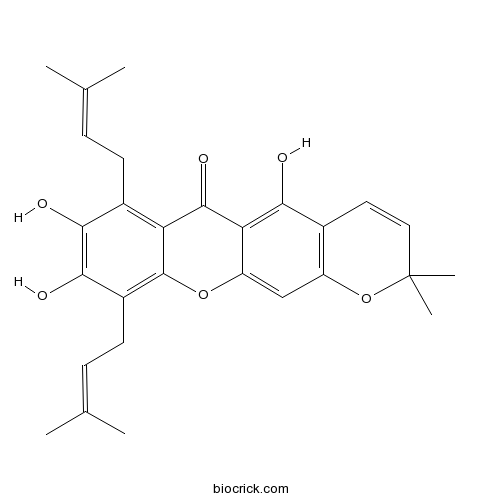Butyraxanthone BCAS# 1141754-81-5 |

Quality Control & MSDS
3D structure
Package In Stock
Number of papers citing our products

| Cas No. | 1141754-81-5 | SDF | Download SDF |
| PubChem ID | 25073518 | Appearance | Yellow powder |
| Formula | C28H30O6 | M.Wt | 462.5 |
| Type of Compound | Xanthones | Storage | Desiccate at -20°C |
| Solubility | Soluble in Chloroform,Dichloromethane,Ethyl Acetate,DMSO,Acetone,etc. | ||
| Chemical Name | 5,8,9-trihydroxy-2,2-dimethyl-7,10-bis(3-methylbut-2-enyl)pyrano[3,2-b]xanthen-6-one | ||
| SMILES | CC(=CCC1=C2C(=C(C(=C1O)O)CC=C(C)C)OC3=CC4=C(C=CC(O4)(C)C)C(=C3C2=O)O)C | ||
| Standard InChIKey | RSIYYKNXUHFPPG-UHFFFAOYSA-N | ||
| Standard InChI | InChI=1S/C28H30O6/c1-14(2)7-9-17-21-26(32)22-20(13-19-16(23(22)29)11-12-28(5,6)34-19)33-27(21)18(10-8-15(3)4)25(31)24(17)30/h7-8,11-13,29-31H,9-10H2,1-6H3 | ||
| General tips | For obtaining a higher solubility , please warm the tube at 37 ℃ and shake it in the ultrasonic bath for a while.Stock solution can be stored below -20℃ for several months. We recommend that you prepare and use the solution on the same day. However, if the test schedule requires, the stock solutions can be prepared in advance, and the stock solution must be sealed and stored below -20℃. In general, the stock solution can be kept for several months. Before use, we recommend that you leave the vial at room temperature for at least an hour before opening it. |
||
| About Packaging | 1. The packaging of the product may be reversed during transportation, cause the high purity compounds to adhere to the neck or cap of the vial.Take the vail out of its packaging and shake gently until the compounds fall to the bottom of the vial. 2. For liquid products, please centrifuge at 500xg to gather the liquid to the bottom of the vial. 3. Try to avoid loss or contamination during the experiment. |
||
| Shipping Condition | Packaging according to customer requirements(5mg, 10mg, 20mg and more). Ship via FedEx, DHL, UPS, EMS or other couriers with RT, or blue ice upon request. | ||
| Description | 1. Butyraxanthone B exhibits good antiplasmodial activity. |
| Targets | Antifection |

Butyraxanthone B Dilution Calculator

Butyraxanthone B Molarity Calculator
| 1 mg | 5 mg | 10 mg | 20 mg | 25 mg | |
| 1 mM | 2.1622 mL | 10.8108 mL | 21.6216 mL | 43.2432 mL | 54.0541 mL |
| 5 mM | 0.4324 mL | 2.1622 mL | 4.3243 mL | 8.6486 mL | 10.8108 mL |
| 10 mM | 0.2162 mL | 1.0811 mL | 2.1622 mL | 4.3243 mL | 5.4054 mL |
| 50 mM | 0.0432 mL | 0.2162 mL | 0.4324 mL | 0.8649 mL | 1.0811 mL |
| 100 mM | 0.0216 mL | 0.1081 mL | 0.2162 mL | 0.4324 mL | 0.5405 mL |
| * Note: If you are in the process of experiment, it's necessary to make the dilution ratios of the samples. The dilution data above is only for reference. Normally, it's can get a better solubility within lower of Concentrations. | |||||

Calcutta University

University of Minnesota

University of Maryland School of Medicine

University of Illinois at Chicago

The Ohio State University

University of Zurich

Harvard University

Colorado State University

Auburn University

Yale University

Worcester Polytechnic Institute

Washington State University

Stanford University

University of Leipzig

Universidade da Beira Interior

The Institute of Cancer Research

Heidelberg University

University of Amsterdam

University of Auckland

TsingHua University

The University of Michigan

Miami University

DRURY University

Jilin University

Fudan University

Wuhan University

Sun Yat-sen University

Universite de Paris

Deemed University

Auckland University

The University of Tokyo

Korea University
- Kuguacin N
Catalog No.:BCN3056
CAS No.:1141453-73-7
- Kuguacin J
Catalog No.:BCN3055
CAS No.:1141453-65-7
- Tirandalydigin
Catalog No.:BCN1860
CAS No.:114118-91-1
- Cabozantinib malate (XL184)
Catalog No.:BCC4388
CAS No.:1140909-48-3
- Ibandronic acid
Catalog No.:BCC5204
CAS No.:114084-78-5
- Humantenidine
Catalog No.:BCN4754
CAS No.:114027-39-3
- 16-Epivoacarpine
Catalog No.:BCN3940
CAS No.:114027-38-2
- Phaclofen
Catalog No.:BCC6562
CAS No.:114012-12-3
- Phenformin
Catalog No.:BCC9120
CAS No.:114-86-3
- Neostigmine Bromide
Catalog No.:BCC4563
CAS No.:114-80-7
- Scopolamine hydrobromide
Catalog No.:BCN1199
CAS No.:114-49-8
- Erythromycin
Catalog No.:BCC4778
CAS No.:114-07-8
- Z-Ala-OH
Catalog No.:BCC3055
CAS No.:1142-20-7
- PAOPA
Catalog No.:BCC6353
CAS No.:114200-31-6
- Puerarin 6''-O-xyloside
Catalog No.:BCN2780
CAS No.:114240-18-5
- CI 976
Catalog No.:BCC7299
CAS No.:114289-47-3
- Soyacerebroside I
Catalog No.:BCN6022
CAS No.:114297-20-0
- Guanosine Hydrate
Catalog No.:BCC5326
CAS No.:1143525-19-2
- AZD5363
Catalog No.:BCC1073
CAS No.:1143532-39-1
- TAK 21d
Catalog No.:BCC5609
CAS No.:1143578-94-2
- Fmoc-D-Leu-OH
Catalog No.:BCC3511
CAS No.:114360-54-2
- PF-8380
Catalog No.:BCC1857
CAS No.:1144035-53-9
- WYE-125132 (WYE-132)
Catalog No.:BCC4608
CAS No.:1144068-46-1
- Beta-Furoyleupatolide
Catalog No.:BCN6407
CAS No.:114437-24-0
Cytotoxic and antiplasmodial xanthones from Pentadesma butyracea.[Pubmed:19296616]
J Nat Prod. 2009 May 22;72(5):954-7.
Four new xanthones, butyraxanthones A-D (1-4), were isolated from the stem bark of Pentadesma butyracea, together with six known xanthones (5-10) and a triterpenoid (lupeol). The structures of 1-4 were established by spectroscopic methods. Compounds 1-10 were tested in vitro for antiplasmodial activity against a Plasmodium falciparum chloroquine-resistant strain and for cytotoxicity against a human breast cancer cell line (MCF-7). Nearly all of these xanthones exhibited good antiplasmodial activity, and some of them also demonstrated potent cytotoxicity.


